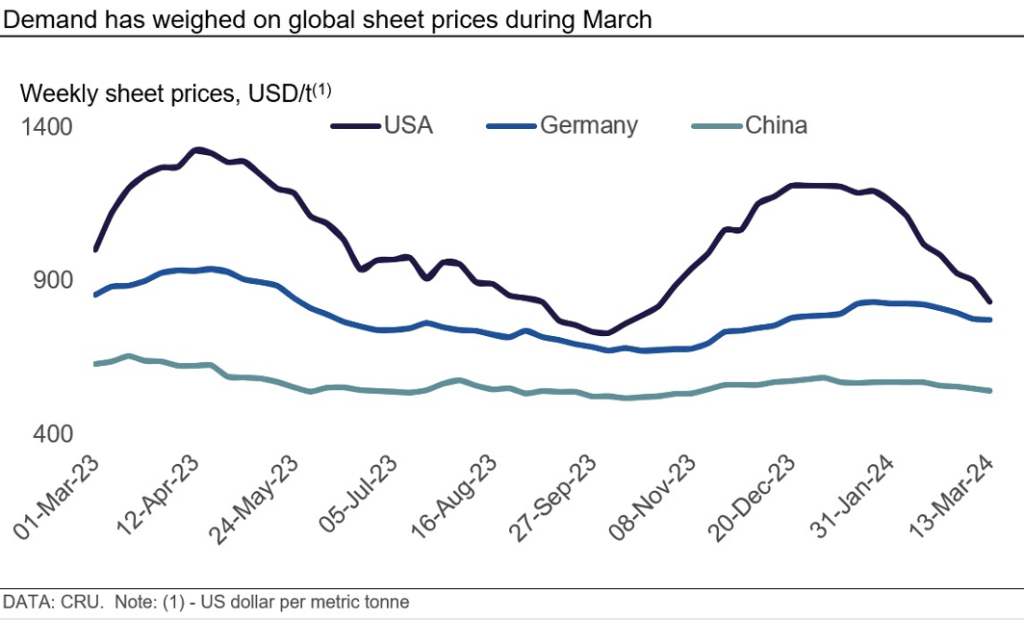Steel Products

CRU: World sheet markets face downward demand-side pressure
Written by Ryan McKinley
March 15, 2024
The CRUspi fell by 8.3% month over month (m/m) in March to 206.6 as weaker-than-expected demand weighed on markets around the world. Price falls were notable across all regions, with elevated inventory levels pushing prices in the US and Europe, and disappointing stimulus measures from the Chinese government weighing on those in Asia.

Weakening demand was the story for sheet markets across the globe this month. US price falls were again large m/m as end-use demand surprised to the downside, inventory levels remained elevated, and new capacity fought for market share. Early-year price rises in Europe also came to a halt, and buyers pulled back from the market on weakness in many key end-use sectors and competitive import offer levels. These same market dynamics were at play across Asia, with Chinese stimulus measures less supportive than hoped and production costs falling.
North American prices again faced pressure due to an ongoing imbalance between supply and demand. Mill lead times are still relatively short, service center inventories plentiful, and newly installed capacity is finally up and fighting for market share. What is more, import price levels remain quite competitive relative to the current domestic market. Compounding this is a slowdown in demand, with market participants growing increasingly bearish on market direction in the coming months even after recently announced mill price increases.
European sheet demand is also low. Stockholders have restored inventories back to sufficient levels, and key end-use sectors activity remains subdued. Steel production capacity that has restarted in recent months is still up, although we do not expect that there will be additional restarts any time soon. Meanwhile, in Turkey, inflation, currency devaluation, and stricter monetary policy are constraining demand and, in addition to attractive import levels, are weighing on prices.
Post-holiday demand in Asia has not returned to the market as strong as some expected. The Two Sessions meeting in China, which typically drives prices higher because of newly announced stimulus measures, did not live up to expectations this year—particularly for the construction sector. Prices in Southeast Asia also fell this month in the lead up to Ramadan, which reduced buying activity and because of falling costs. Japanese prices fell for the first time this year as well on weakening export demand by key export destinations, except by the US.

This article was first published by CRU. Learn more about CRU’s services at www.crugroup.com/analysis.

Ryan McKinley
Read more from Ryan McKinleyLatest in Steel Products

CRU: US rebar and wire rod prices rise alongside S232 increase
CRU Senior Steel Analyst Alexandra Anderson discusses current market and pricing dynamics for long steel products in the US.
CRU: Excessive global supply could hit rebar mill investments in US
Following the onset of the war in Ukraine in March 2022, concerns about import availability and expectations of rising demand from President Biden’s Infrastructure Bill pushed US rebar prices to record highs. In response, a flurry of new mills and capacity expansions were announced to meet the rise in demand from growth in the construction […]

Steel buyer spirits tempered by soft spot market conditions
Steel sheet buyers report feeling bogged down by the ongoing stresses of stagnant demand, news fatigue, tariff negotiations or implementation timelines, and persistent macroeconomic uncertainty.

CRU: US stainless prices to rise on expanded S232 tariffs
Stainless prices in the US market will rise, following price increases by major US producers. Our base case scenario incorporates higher US prices in the near term, despite the initial negative reaction by the market. US stainless prices will go up in 2025 H2 and will stay elevated in 2026 as tariffs on stainless […]

Galvanized steel demand unsteady amid lingering buyer fatigue: HARDI
Uneven demand for galvanized steel in June reflects a market that remains mired in uncertainty, according to industry sources.
